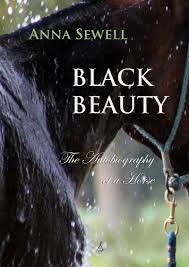When I blogged about my top 10 animals in children’s fiction back in September I promised to follow up with my favourite horse characters, because I felt they deserved a list of their own. Finally, here it is.
I was a sucker for a pony story as a child, and I read anything I could find in my local library with a horse on the cover or a hint of one in the title. I must have consumed a lot of rubbish about gymkhanas and curry combs and five-barred-gates which I have completely forgotten now. Looking at my choices of rather more classic books below, I realise they are all highly dramatic, and highly romantic – even, at a pinch – the Thelwell ponies, who are the objects of their girl-riders’ romantic affections.
1. Black Beauty by Anna Sewell (1877). I blogged about this book here and here. Beauty is beautiful (natch) in looks and temperament, honest, ill-used, and eloquent in this, his ‘Autobiography Of A Horse’. He is the template against which all other fictional horses – and many human heroes and heroines – are measured. And fall a little short.
2. Thelwell ponies – any of the cartoon ponies created by the (somewhat reluctant) Norman Thelwell. They are the complete antidote to all the other noble equines here. Thelwell ponies are short, fat, hairy, stubborn, lazy, and selfish, and not even very good at natural horsey skills. Unless by natural horsey skills we mean kicking, bucking, shying, braking suddenly, and foraging in hedges. Yet they are still adored by their owners and riders, and readers of the little books like A Leg At Each Corner (1961). The nearest I could get to having a bloody-minded little Merrylegs of my own.
3. Thowra in The Silver Brumby by Elyne Mitchell (1958). Thowra is a wild Australian horse whose pale colour marks him out to other horses and to threatening humans, so already as a colt he has the makings of a persecuted hero. I loved Mitchell’s tale, told from the horses’ point of view without anthropomorphising them. A story firmly rooted in the natural world and using Thowra’s knowledge of it, so yet another strand that appealed to me as a child – and still does.
4. Flicka in My Friend Flicka by Mary O’Hara (1941). I watched loads of Westerns as a child. Cowboy films and TV series seemed to be the common dramatic staple then, just as cop/crime shows are now. My Friend Flicka, set on a Wyoming ranch, fulfilled my love of all things outdoorsy while I lay on the sofa with my nose in a book! It has the best ingredients: our sympathetic attraction to the underdog (the least favourite son, the filly that isn’t wanted), family rivalry and injustice, learning, love and loyalty. It also features serious injury, life-threatening illness and gruesome details, all of which seemed totally necessary to many of the books I relished, and were seen as perfectly suitable – nay, classic – material for child-readers!
5. Strawberry in The Magician’s Nephew by C S Lewis (1955). Which takes us almost back to Black Beauty, since Strawberry is an overworked cab-horse in Victorian London when he gets whisked by magic to the Wood Between the Worlds and into Narnia as it is created. There Strawberry makes the ultimate transformation into Fledge, not only a flying horse, but a talking one as well. As Fledge he becomes the first in line of all the flying horses of Narnia. I loved the idea of a knackered old working horse finding his youthful strength again, blossoming into a mythical beast, and, as Beauty never could, gaining the capacity to tell humans the truth.
 I’d also like to give an honourable mention to the horses in the Flambards books by K M Peyton, although by the time I discovered these I was more interested in the budding romance between the human characters than the horse-riding stuff. The beautiful, romantic, but accurate equine illustrations by the amazing Victor Ambrus really added to the delight.
I’d also like to give an honourable mention to the horses in the Flambards books by K M Peyton, although by the time I discovered these I was more interested in the budding romance between the human characters than the horse-riding stuff. The beautiful, romantic, but accurate equine illustrations by the amazing Victor Ambrus really added to the delight.
And to The Pie in Enid Bagnold’s National Velvet (1935). This is another novel of transformation, and bears almost no resemblance to the famous film with a young Elizabeth Taylor as plain little slaughter-houseman’s daughter Velvet.
Lastly, though it is definitely not a book for children, Horse Heaven by Jane Smiley (2000) is a wonder. A huge book about the American racing community, it tells parallel stories of jockeys, trainers, breeders, owners, grooms, various hangers-on – plus a dog and several horses! The amazing foal who might become a star, and the experienced old nag who is more than he seems. I have never, ever read anyone who creates the truly alien perceptions of an animal so persuasively before. The heart-wrenching powerlessness of the horses as they inevitably change hands, even on the way up in value, let alone on the way down, takes me right back to where I started, with Black Beauty.














